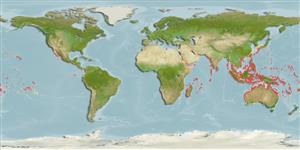Common names from other countries
Environment: milieu / climate zone / depth range / distribution range
Ecologie
; diepteverspreiding 0 - 20 m (Ref. 348). Tropical
Indo-West Pacific: from eastern and southern Africa, to western Polynesia; north to Japan and Hawaii, and south to New Caledonia; Society Islands, eastern Polynesia.
Length at first maturity / Size / Gewicht / Leeftijd
Maturity: Lm ? range ? - ? cm Max length : 7.5 cm ShL mannelijk/geslacht niet bekend; (Ref. 348); common length : 4.0 cm SL mannelijk/geslacht niet bekend; (Ref. 348)
Byssally attached to rocks, on reef flats or to the underside of boulders, on sand and gravel bottoms. May also occur at sub-littoral (Ref. 348) and intertidal depths on soft sediments (Ref. 87907).
Life cycle and mating behavior
Geslachtsrijpheid | Voortplanting | Kuitschieten | Eieren | Fecundity | Larven
Members of the class Bivalvia are mostly gonochoric, some are protandric hermaphrodites. Life cycle: Embryos develop into free-swimming trocophore larvae, succeeded by the bivalve veliger, resembling a miniature clam.
Poutiers, J.M. 1998. (Ref. 348)
Status op de Rode Lijst van het IUCN (Ref. 130435)
Status bij CITES (Ref. 108899)
Not Evaluated
Not Evaluated
Gevaarlijk voor mensen
Harmless
Gebruik door de mens
| FishSource |
Tools
Meer informatie
Leeftijd/GrootteGroeiLengte-gewicht parametersLengte-lengte parametersMorfologieLarvenAbundantie
Internet-bronnen
Estimates based on models
Preferred temperature
(Ref.
115969): 24.6 - 29.3, mean 28.4 (based on 3503 cells).
Kwetsbaarheid
Low vulnerability (10 of 100).
Prijsklasse
Unknown.
